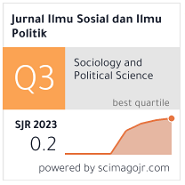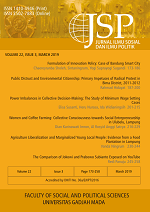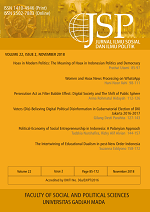Responding to Elite Consolidation: the Anti-Cement-Factory Movement Resisting Oligarchy in an Indonesian Local Election
Arif Novianto(1), Anindya Dessi Wulansari(2*)
(1) Institute of Governance and Public Affairs, Master of Public Administration, Universitas Gadjah Mada, Indonesia
(2) Public Administration, Universitas Tidar, Indonesia
(*) Corresponding Author
Abstract
This study demonstrates resistance to oligarchic forces with a case study from Pati Regency, Central Java, Indonesia. The movement started with a protest against the expansion of the internationally financed Indocement Tunggal Prakarsa Ltd in the Kendeng Mountains. The anti-cement-factory movement lived on and ‘defeated’ the oligarchs in the electoral districts where the movement happened in the 2017 Pati local election. This study uses a qualitative method. Data were collected from in-depth interviews between December 2016 and July 2017 with 16 social movement leaders and three regional leader’s election campaign team members. The findings show that oligarchy as a power relation system can be challenged, putting into question the belief that oligarchy as a power relation system in democracy is unchallenged. This case study in Pati Regency has shown that resistance on the grassroots level, albeit sporadic, was able to challenge the oligarchy.
Keywords
Full Text:
PDFReferences
Ambardi, K. (2009). Mengungkap politik kartel: Studi tentang sistem kepartaian di Indonesia era reformasi. Jakarta: Kepustakaan Populer Gramedia.
Araghi, F. (2012). The invisible hand and the visible foot: peasants, dispossession and globalization. In Akram-Lodhi, A., & Kay, C.(Eds.), Peasants and globalization (pp. 123-159). London: Routledge. doi: https://doi.org/10.4324/9780203891834
Aspinall, E. (2014). Agensi dan Kepentingan Massa dalam Masa Transisi dan Konsolidasi Demokrasi di Indonesia. Prisma, 33(1), 77-97.
Choi, N. (2009). Democracy and patrimonial politics in local Indonesia. Indonesia, 88, 131-164.
Department Hubungan Internasional UGM. (2019). Untuk apa nirkekerasan kalau…. Retrieved from https://iis.fisipol.ugm. ac.id/2019/10/03/untuk-apa-nirkekerasan- kalau/
Fukuoka, Y. (2012). Politics, business and the state in post-Soeharto Indonesia. Contemporary Southeast Asia, 34(1), 80-100.
Hadiz, V. (2004). Dec entralization and democracy in Indonesia: A critique of neo-institutionalist perspectives. Development and Change, 35(4), 697-718. doi: https:// doi.org/10.1111/j.0012-155X.2004.00376.x
Hadiz, V., & Robison, R. (2004). Reorganising power in Indonesia: The politics of oligarchy in an age of markets. London: Routledge.
KPU. (2013). Hasil Hitung Pilkada Pati 2013.KPU Pati.
KPU. (2017). Hasil Hitung TPS (Form C1) Kabupaten Pati-Pilkada 2017. Retrieved from https://pilkada2017.kpu.go.id/hasil/ t2/jawa_tengah/pati
Lane, M. (2008). Unfinished nation: Indonesia before and after Suharto. London: Verso.
Lay, C., Hanif, H., & Rohman, N. (2017). The Rise of Uncontested Elections in Indonesia: Case Studies of Pati and Jayapura. Contemporary Southeast Asia, 39(2), 427-448.
Maxwell, J. A. (2008). Designing a qualitative study. California: SAGE Publication.
Mietzner, M. (2007). Party financing in post-Soeharto Indonesia: between state subsidies and political corruption. Journal Contemporary Southeast Asia, 29 (2), 238- 263. doi: 10.1355/cs29-2b
Mietzner, M. (2010). Indonesia’s direct elections: Empowering the electorate or entrenching the New Order oligarchy. In E. Aspinall & G. Fealy (Eds.), Soeharto's New Order and Its Legacy: Essays in honour of Harold Crouch. Canberra: ANU Press
Novianto, A. (2016). Perlawanan rakyat: Analisis gerakan kontra-hegemoni dalam ekonomi politik kebijakan pembangunan pabrik semen di Pati. (Thesis S1), Universitas Gadjah Mada, Yogyakarta.
Novianto, A. (2018). Berebut Saminisme: Artikulasi Politik Masyarakat Adat dalam Konflik Pembangunan Pabrik Semen di Pegunungan Kendeng. In Kumorotomo, W., & Purbokusumo, Y. (Eds.), Kebijakan Publik dalam Pusaran Perubahan Ideologi dari Kuasa Negara ke Dominasi Pasar. Yogyakarta: UGM Press.
Pleines, H. (2016). Oligarchs and politics in Ukraine. Demokratizatsiya: The Journal of Post-Soviet Democratization, 24(1), 105-127.
Tan, P. J. (2006). Indonesia seven years after Soeharto: party system institutionalization in a new democracy. Journal Contemporary Asia, 28(1), 88-114. doi: 10.1355/cs28-1e
Tawakkal, G. T. I., & Garner, A. D. (2017). Unopposed but not Uncontested: Brokers and" Vote Buying" in the 2017 Pati District Election. Contemporary Southeast Asia, 39(3), 491-510.
WartaPati. (2017). Sosialisasi di Dukuhseti sukses namun kembali dibubarkan. Warta Photo. Retrieved from https://www.wartaphoto.net/sosialisasi-kotak-kosong- di-dukuhseti-sukses-namun-kembali- dibubarkan/
Winters, J. A. (2011). Oligarchy. Cambridge: Cambridge University Press.
Winters, J. A. (2014). Oligarchy and Democracy in Indonesia. Indonesia, 96, 11–33. https:// doi.org/10.5728/indonesia.96.0099
Article Metrics
Refbacks
- There are currently no refbacks.
Copyright (c) 2023 Jurnal Ilmu Sosial dan Ilmu Politik

This work is licensed under a Creative Commons Attribution-NonCommercial-NoDerivatives 4.0 International License.






















